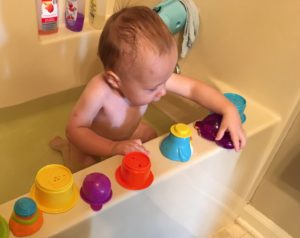
Patterning, which happens through rhythms is actually early algebra, as algebra is understanding classification of objects and patterns. As your baby explores his world, he learns to classify and sort objects mentally. He is already learning how to “sort” these items into categories, such as people, toys, and food. As he gets older he can learn to actually put like items into a pattern such as cheerio, blueberry, cheerio, blueberry and so on. This is an important early math skill that lays the ground work for higher level thinking and algebra and by creating these patterns, it teaches your child what to expect next. Lining up items in a row is helpful for babies to understand the relationship between the items, before learning the concept of patterning.
You can help your baby start to learn this concept of patterning through repetition, rhyming, and simply saying patterns out loud. For example, “You have a blue cup, and a red cup, a blue cup, and a red cup, and so on.”
You can add movement to the pattern. For example, “I am giving you a kiss and a hug, a kiss, and a hug, a kiss, and a hug…” You are creating a foundation for rhythm and patterns.
You can find a lot of patterns in nature. Point this out to your baby on petals on a flower, pebbles on the ground…
As he gets older, build on this by using small items to demonstrate the pattern. When she is two or three years old, you can create a pattern of stringing beads: Red, yellow, blue, red, yellow, blue. You can point to each one as you say the color so she starts to understand the one-to-one correspondence of each bead to the words you are using. By then she will understand the concept of patterning because you would have pointed it out so many times to her as a baby. When you ask her what comes next she will be able to predict red! What a clever little scientist you will have!
Reference:
Barbre, J. (2017). Baby Steps to STEM; Infant and Toddler Science, Technology, Engineering, and Math Activities. Redleaf Press.
NAEYC (National Association for the Education of Young Children). (2012). Technology and Interactive Mediaas Tools in Early Childhood Programs Serving Children from Birth through Age 8. A joint position statement of the National Association for the Education of Young Children and the Fred Rogers Center for Early Learning and Children’s Media at Saint Vincent College. Retrieved from NAEYC Technology and Interactive media as tools in early childhood programs

